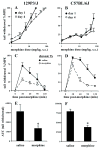Morphine analgesic tolerance in 129P3/J and 129S6/SvEv mice
- PMID: 17196637
- PMCID: PMC1905890
- DOI: 10.1016/j.pbb.2006.11.012
Morphine analgesic tolerance in 129P3/J and 129S6/SvEv mice
Abstract
Morphine analgesic tolerance is heritable in both humans and rodents, with some individuals and strains exhibiting little and others exhibiting robust tolerance. 129S6/SvEv and 129P3/J mice reportedly do not demonstrate tolerance to morphine analgesia. Using our laboratory's standard morphine tolerance regimen and a between-subjects design, tolerance developed in the hot plate and tail withdrawal assays as indicated by a change in analgesic efficacy following a morphine challenge dose. Furthermore, the non-competitive NMDA receptor antagonist MK-801 (dizocilipine) blocked morphine tolerance in 129S6/SvEv and CD-1 mice in the hot plate assay. As previously reported, when a within-subjects design and cumulative dosing was employed, no tolerance was observed in the 129P3/J strain. However, using the same morphine regimen and a between-subjects design, comparable tolerance developed between 129P3/J and C57BL/6J strains following a single challenge dose of morphine. Spontaneous hyperalgesia was observed in the tail withdrawal assay following chronic morphine in C57BL/6J, but not 129P3/J mice. Additionally, morphine-tolerant C57BL/6J mice, but not 129P3/J mice, exhibited a large increase in the frequency of tail flicks during the first second following the baseline nociceptive response which may facilitate detection of the response during the tolerant state. We conclude that the method of tolerance assessment affects the ability to detect tolerance and thus may affect the degree and pattern of heritability of this trait and this could have implications for gene mapping studies.
Figures





References
-
- Ben-Bassat J, Peretz E, Sulman FG. Analgesimetry and ranking of analgesic drugs by the receptacle method. Arch Int Pharmacodyn Ther. 1959;122:434–47. - PubMed
-
- Bryant CD, Eitan S, Sinchak K, Fanselow MS, Evans CJ. NMDA Receptor Antagonism Disrupts the Development of Morphine Analgesic Tolerance in Male, but not Female C57BL/6J Mice. Am J Physiol Regul Integr Comp Physiol. 2006 - PubMed
-
- Bryant CD, Zaki PA, Carroll FI, Evans CJ. Opioids and Addiction: Emerging pharmaceutical strategies for reducing reward and opponent processes. Clinical Neuroscience Research. 2005;5:103–115.
-
- Crain SM, Shen K. Enhanced analgesic potency and reduced tolerance of morphine in 129/SvEv mice: evidence for a deficiency in GM1 ganglioside-regulated excitatory opioid receptor functions. Brain Res. 2000;856:227–35. - PubMed
-
- Dunbar S, Yaksh TL. Concurrent spinal infusion of MK801 blocks spinal tolerance and dependence induced by chronic intrathecal morphine in the rat. Anesthesiology. 1996;84:1177–88. - PubMed
Publication types
MeSH terms
Substances
Grants and funding
LinkOut - more resources
Full Text Sources
Medical
Research Materials

